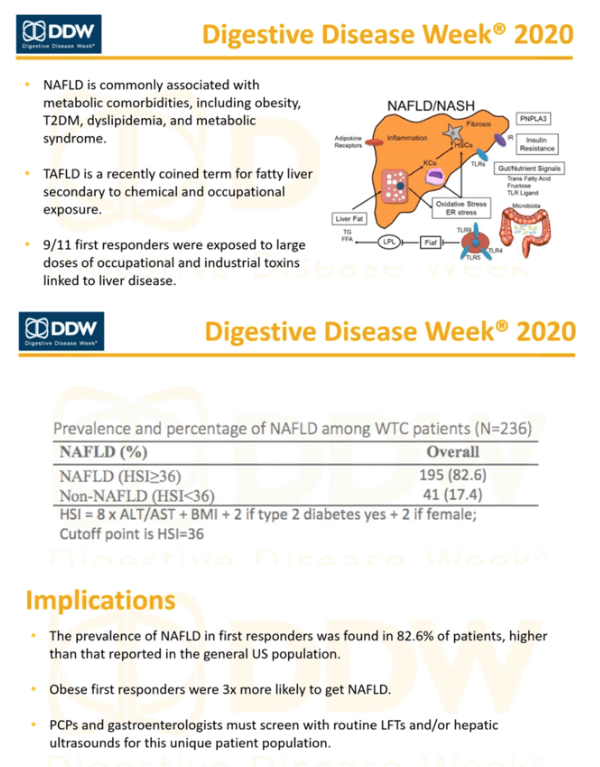| |
Study Finds Highly Elevated Levels of
Fatty Liver Disease for 9/11 First Responders
|
| |
| |
• Thursday, April 30, 2020
Toxins released at 2001 World Trade Center disaster linked to doubling incidence
Download the PDF here
Preview: DDW 2020 ePosters + ePapers Release This Weekend
https://www.ddwnews.org/news/preview-ddw-2020-eposters-epapers-release-this-weekend/
Bethesda, MD (April 30, 2019) - Toxin exposure appears to have contributed to dramatically higher rates of fatty liver disease among first responders to the attack on the World Trade Center on Sept. 11, 2001, according to research that was selected for presentation at Digestive Disease Week® (DDW) 2020. DDW® data will be published in the May online supplements to Gastroenterology and GIE: Gastrointestinal Endoscopy.
"Non-alcoholic fatty liver disease (NAFLD), one of the most serious diseases of the digestive system, is generally thought to be caused by obesity, metabolic syndrome and poor lifestyle choices," said Mishal Reja, MD, resident physician in internal medicine at Robert Wood Johnson University Hospital, Newark, New Jersey, and a lead researcher of the study. "However, recent research shows a higher burden of this disease among workers exposed to environmental toxins in coal mining, demolition and factories. This exposure is similar to the toxins faced by 9/11 responders."
Reja and his team reviewed medical records of 243 first responders with gastrointestinal symptoms who were referred to the World Trade Center Health Program between January 2014 and August 2019. Testing for signs of fatty liver disease and comorbidities, researchers found nearly 83 percent had fatty liver disease compared to 24 to 45 percent in the general population.
"This research shows that 9/11 first responders need to be particularly concerned about fatty liver disease, and they must be examined more closely for it. Additionally, they should be especially careful in managing their diet and any related comorbidities because their risk for fatty liver disease is compounded by toxin exposure," said Dr. Reja.
Toxin-associated fatty liver disease (TAFLD) was recently identified as a form of NAFLD among people exposed to chemicals and toxins. Researchers believe occupational and industrial toxins disrupt endocrine signaling, causing weight gain associated with type 2 diabetes and fatty liver, which can lead to a host of life-threatening conditions, including liver cancer and cirrhosis.
Previous studies have confirmed that workers involved in the cleanup and recovery efforts at the World Trade Center have suffered a variety of health conditions, including digestive disorders, such as acid reflux, and respiratory disorders, such as lung disease, COPD and asthma. However, the effect on the liver has not been closely studied.
In addition to providing a warning to first responders and their families, this research adds to the literature linking environmental chemicals and TAFLD. To build on this research, Dr. Reja and his team hope to compare liver ultrasounds of first responders to a control group of the general population to gather more detailed information on the rate of TAFLD.
Last Updated April 30, 2020
There was no outside funding provided for the study (Mo1507).
press briefing
https://www.dropbox.com/s/ez7nhmzfxf0enu9/Digestive Disease Week® (DDW) 2020 Media Briefing .mp4?dl=0
These particular workers were referred to the program after reporting GI symptoms: predominantly gastroesophageal reflux, but also including dysphagia and general abdominal pain. Reja and colleagues suspected TAFLD would be highly prevalent in the group.
During his online presentation, Reja explained that building materials often contain endocrine-disrupting chemicals such as polycyclic aromatic hydrocarbons and vinyl chloride, which in turn have been linked in prior research to fatty liver disease, i.e., TAFLD. These compounds can easily be liberated during demolition work, for example. Massive quantities are known to have been released during the Trade Center buildings' collapse and subsequent debris removal.
Reja noted, too, that past studies of other occupational exposures to these substances showed "extremely high rates [of TAFLD] consistent with the rates we found in our study."
He added that TAFLD can be distinguished from ordinary non-alcoholic fatty liver disease in liver biopsies -- "they have different inflammatory markers" and a "different histological picture" -- but he also acknowledged that pathologists may disagree on particular biopsy samples for diagnosing TAFLD.
Ground Zero workers referred to Reja's clinic were assessed with the HSI, which combines body mass index, gender, diabetes mellitus presence, and the ratio of alanine to aspartate aminotransferase to generate a numeric score. Previous studies indicated a cutoff of 36 is 93.1% sensitive for fatty liver, his group noted.
The 82.6% prevalence of scores above 36 stands in contrast to estimates of 24%-45% in the general population, Reja noted.
DDW Chair Grace Elta, MD, of the University of Michigan in Ann Arbor, who served as discussant for the press program, said the prevalence of fatty liver in this group "seems extremely high," and asked how those individuals may have differed from those not meeting the HSI threshold.
Reja noted that obesity was strongly associated with fatty liver in the group (adjusted OR 3.26, 95% CI 2.24-5.50). Besides reflux disease, common comorbidities included hypertension (40%), chronic rhinosinusitis (67%), and obstructive sleep apnea (52%).
Also, the group with HSI scores greater than 36 were more likely than others in the cohort to show gastritis on endoscopy (68.9% vs 50.0%).
Reja concluded that the findings suggest that healthcare professionals -- primary care providers and gastroenterologists in particular -- be alert for fatty liver disease in Ground Zero workers. Routine liver function tests and/or hepatic ultrasound exams should be considered, he said......
https://www.medpagetoday.com/meetingcoverage/ddw/86245?xid=nl_mpt_DHE_2020-05-01&eun=g92748d0r&utm_source=Sailthru&utm_medium=email&utm_campaign=Daily Headlines Top Cat HeC 2020-05-01&utm_term=NL_Daily_DHE_dual-gmail-definition

###
Digestive Disease Week® (DDW) is the largest international gathering of physicians, researchers and academics in the fields of gastroenterology, hepatology, endoscopy and gastrointestinal surgery. Jointly sponsored by the American Association for the Study of Liver Diseases (AASLD), the American Gastroenterological Association (AGA) Institute, the American Society for Gastrointestinal Endoscopy (ASGE) and the Society for Surgery of the Alimentary Tract (SSAT), DDW showcases more than 5,000 abstracts and hundreds of lectures on the latest advances in GI research, medicine and technology. More information can be found at www.ddw.org.
|
|
| |
| |
|
|
|